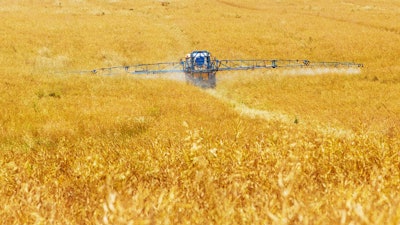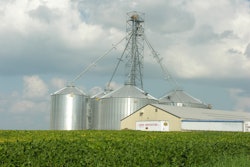
Chemicals play an important role in the agricultural world. Some chemicals, like propane, are used for fuel while others protect crops from pests.
Without the aid of chemical fertilizers, industrial farmers and feed mills would never be able to produce crops in the quantities they do today. But chemicals have an ugly side, as well.
Anyone who’s taken Chemistry 101 knows that chemicals can be harmful when used improperly. Life-threatening consequences can occur if stored incorrectly, at the wrong temperature or mixed with other chemicals.
The most recent fear we face with chemicals is their ability to aid terrorists in chemical warfare.
To combat the threat chemicals pose when in the wrong hands, the Department of Homeland Security (DHS) has updated its chemical security program, called the Chemical Facility Anti-Terrorism Standards (CFATS), so high-risk facilities can be monitored more closely.
Input from the agricultural community was taken into consideration when formulating the new standards. Dennis Deziel, acting deputy director, DHS Chemical Security Compliance Division (CSCD), presented “DHS’ Chemical Security Rule — Impacts on Country Elevators and Feed Mills” at the 2007 Country Elevator show in Chicago this past December.
“The agricultural community has provided invaluable insight to the Department of Homeland Security in the development of the regulations, and DHS continues to maintain a substantive and valuable dialogue with the agricultural community,” says Deziel.
He lays out the reasons for the new regulations, how to find out if your facility is high-risk and how this will affect day-to-day operations of feed mills, grain elevators and other agricultural facilities.
DEFINING CFATS
The Chemical Facility Anti-Terrorism Standards (CFATS) is a broad term covering the governmental regulations regarding the chemical security program.
After the DHS Appropriation Act of 2007 was passed, the department was given six months to plan and implement the new law. During those six months, the DHS comprised and published a preliminary Chemicals of Interest List and released it to the public for comment. Based on industry feedback, including comments from the agricultural sector, the Chemicals of Interest List was slightly modified.
On Nov. 20, 2007, the DHS published the CFATS Interim Final Rule, which included the revised Chemicals of Interest List (known as Appendix A containing more than 300 chemicals. Each has a Screening Threshold Quantity (STQ), or maximum amount allowed of a particular chemical. This is used to decide if a facility needs to fill out a Top-Screen form, and what the form reports determines if a facility is high-risk or not. Facilities whose Top-Screen qualifies them as high-risk are subject to regular inspections by the DHS.
“Since the publication of the final Appendix A, additional questions have been raised regarding the applicability of the Top-Screen requirement to agricultural facilities and operations,” Deziel explains. “The DHS is gathering more information concerning these issues to determine whether any modification of the Top-Screen requirement might be warranted, if any.”
Originally the DHS stated all facilities that possess a chemical of interest in any amount needed to fill out a Top-Screen.
“In the final appendix, the Department has established baseline standard threshold quantities for the chemicals of interest for each security issue. Where necessary, the Department has identified a few exceptions,” Deziel notes.
The final interim rule specified only facilities that possess a chemical of interest higher than the STQ will need to fill out a Top-Screen. “The CFATS program was designed to identify, prioritize and secure truly high-risk facilities. It was not intended to impose regulatory requirements on low-risk end-users, such as farms,” he adds.
THE CHEMICAL THREAT
Homeland Security Secretary Michael Chertoff says that Appendix A plays an important role in the federal government’s effort to make it less likely for terrorists to use dangerous chemicals in attacks.
Enhancing security is the main intent of CFATS. The DHS chose three categories of security to focus on when determining which chemicals would make it onto Appendix A. They are release, theft/diversion and sabotage.
The release category includes chemicals that could release a toxic cloud, a flammable vapor or create an explosion that could affect people within and beyond the facility if intentionally released.
The theft and diversion category includes chemicals that could be stolen and used as chemical weapons or easily converted into chemical weapons or explosives.
The third category, sabotage/contamination, refers to chemicals that, if mixed with other readily available materials, could present deathly consequences to human life and health.
Many agricultural facilities possess chemicals and fertilizers that fall under these three categories.
THE AGRICULTURAL EXTENSION
You may be wondering how all these new regulations will affect your day-to-day operations. For most facilities, such as feed mills, ethanol plants and other grain producers, that question can’t be answered until a Top-Screen is filled out and submitted.
According to the final Appendix A of CFATS, facilities in possession of a chemical of interest that meets or exceeds the STQ set by the DHS must submit a Top-Screen online, within 60 calendar days of coming into possession of the chemical.
Following the issuance of Appendix A, legislative developments and unforeseen consequences required further review of the CFATS regulatory framework. The focus is chemicals of interest widely used throughout the agricultural community. To conduct a thorough review of these issues, the DHS granted an indefinite extension for facilities that possess a chemical of interest above the STQ solely for the treatment of crops, feed, land, livestock or other areas of an agricultural production facility.
“The agricultural extension letter provides an indefinite extension for Top-Screen submissions to certain facilities in the agricultural community while the Department develops a successful approach for the agricultural community,” says Deziel.
The extension applies to facilities such as farms (e.g., crop, fruit, nut and vegetable); ranches and ranchland; poultry, dairy and equine facilities; turf grass growers and golf courses; nurseries; floricultural operations; and public and private parks.
“农业推广不适用于化学ical distribution facilities, commercial chemical application services, Co-ops or retail supply centers. If a facility or farm possesses a chemical of interest at or above the designated Screening Threshold Quantity for reasons other than those specified in the letter, the facility is still required to submit a Top-Screen to the Department,” Deziel says.
The DHS will cooperate with agricultural producers to identify the best ways to regulate frequently used nitrogen fertilizers such as ammonia solutions, anhydrous ammonia and urea.
To determine if your facility is required to complete a Top-Screen form, refer to 72 FR 17688 and 65396 (the agriculture extension letter), on the DHS website atwww.dhs.gov.
PROPANE REGULATIONS
除了扩展,国土安全部specialized approach for certain chemicals like propane to accommodate agricultural facilities’ needs.
It was one of the most significant changes made to Appendix A based on the public’s comments.
“Most notably, the Final Rule has developed a specialized approach for propane, chlorine and ammonium nitrate, largely in response to industry and stakeholder input,” Deziel points out.
The original draft of the Chemicals of Interest List specified 7,500 lbs. as the STQ for propane, a flammable chemical. However, in the DHS’s final version, the STQ for propane was set at 60,000 lbs., the estimated maximum amount of propane that nonindustrial users typically have.
Members of the agriculture and related industries were successful in convincing the DHS that users in rural areas do not have the potential to be a real threat to human life or health. Therefore, the DHS ruled that facilities do not need to include propane in tanks of 10,000 lbs. or less when calculating whether a facility has a total inventory of 60,000 lbs. because they realized that farmers and agricultural users usually possess three or more propane tanks to heat poultry and livestock barns.





















![Optimix Andritz Scaled[1]](https://img.feedandgrain.com/files/base/wattglobalmedia/all/image/2023/05/optimix_Andritz_scaled_1_.645eb7a1ed508.png?auto=format%2Ccompress&fit=crop&h=112&q=70&w=112)